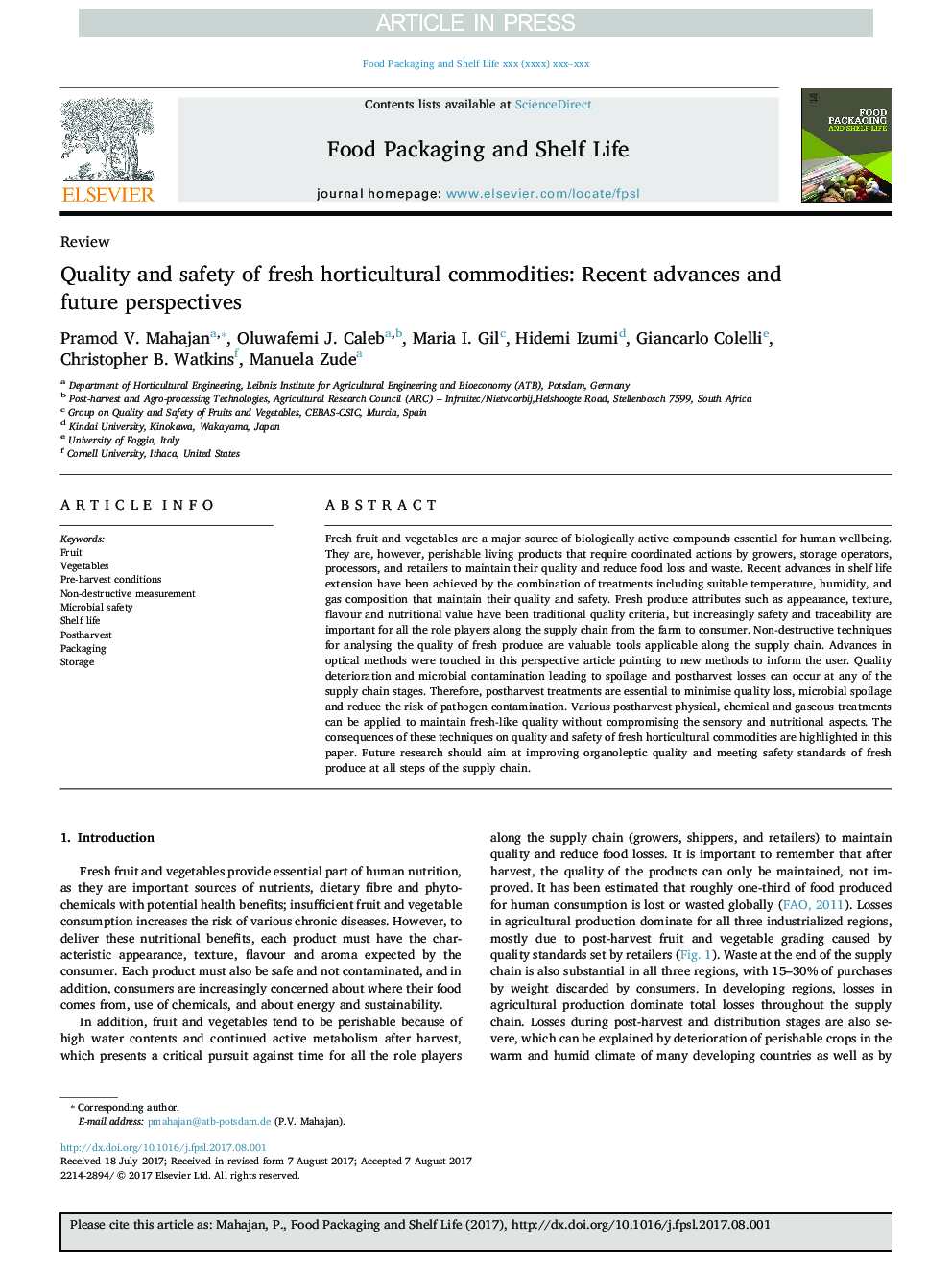| کد مقاله | کد نشریه | سال انتشار | مقاله انگلیسی | نسخه تمام متن |
|---|---|---|---|---|
| 6489344 | 1416510 | 2017 | 10 صفحه PDF | دانلود رایگان |
عنوان انگلیسی مقاله ISI
Quality and safety of fresh horticultural commodities: Recent advances and future perspectives
ترجمه فارسی عنوان
کیفیت و ایمنی کالاهای باغبانی تازه: پیشرفت های اخیر و دیدگاه های آینده
دانلود مقاله + سفارش ترجمه
دانلود مقاله ISI انگلیسی
رایگان برای ایرانیان
کلمات کلیدی
میوه، سبزیجات، شرایط پیش از برداشت، اندازه گیری غیر مخرب، ایمنی میکروبی، عمر مفید پس از برداشت، بسته بندی، ذخیره سازی،
ترجمه چکیده
میوه و سبزیجات تازه یک منبع اصلی ترکیبات فعال بیولوژیکی ضروری برای سلامتی انسان است. با این وجود، محصولات زنده فاسد می شوند که نیاز به اقدامات هماهنگ شده توسط تولید کنندگان، اپراتورهای ذخیره سازی، پردازنده ها و خرده فروشان برای حفظ کیفیت آنها و کاهش میزان مواد غذایی و ضایعات را کاهش می دهد. پیشرفت های اخیر در تمدید عمر مفید با ترکیبی از درمان ها از جمله دمای مناسب، رطوبت و ترکیب گاز که کیفیت و ایمنی آنها را حفظ می کند، به دست آمده است. ویژگی های تازه تولید مثل ظاهر، بافت، عطر و طعم و ارزش غذایی معیارهای کیفیت سنتی، اما به طور فزاینده ایمنی و قابلیت ردیابی برای همه بازیکنان نقش در زنجیره تامین از مزرعه تا مصرف کننده مهم است. تکنیک های غیر مخرب برای تجزیه و تحلیل کیفیت محصولات تازه ابزار ارزشمندی هستند که در طول زنجیره عرضه قابل اجرا هستند. پیشرفت های روش های نوری در این مقاله دیدگاهی مطرح شده است که به روش های جدیدی برای اطلاع رسانی به کاربر می پردازد. تخریب کیفیت و آلودگی میکروبی که منجر به تلفات فساد و تلفات پس از زایمان می شود در هر مرحله از زنجیره تامین رخ می دهد. بنابراین، درمان بعدی بعد از زایمان ضروری است تا از دست دادن کیفیت، فاسد شدن میکروبی و کاهش خطر ابتلا به پاتوژن جلوگیری شود. بعد از زایمان، درمانهای فیزیکی، شیمیایی و گازسوز می تواند برای حفظ کیفیت تازه مانند بدون رعایت جنبه های حسی و تغذیه ای استفاده شود. پیامدهای این تکنیک ها بر کیفیت و ایمنی کالاهای باغبانی تازه در این مقاله برجسته شده است. تحقیقات آینده باید با هدف بهبود کیفیت ارگانولپتیک و رعایت استانداردهای ایمنی محصولات تازه در تمام مراحل زنجیره تامین انجام شود.
موضوعات مرتبط
مهندسی و علوم پایه
مهندسی شیمی
بیو مهندسی (مهندسی زیستی)
چکیده انگلیسی
Fresh fruit and vegetables are a major source of biologically active compounds essential for human wellbeing. They are, however, perishable living products that require coordinated actions by growers, storage operators, processors, and retailers to maintain their quality and reduce food loss and waste. Recent advances in shelf life extension have been achieved by the combination of treatments including suitable temperature, humidity, and gas composition that maintain their quality and safety. Fresh produce attributes such as appearance, texture, flavour and nutritional value have been traditional quality criteria, but increasingly safety and traceability are important for all the role players along the supply chain from the farm to consumer. Non-destructive techniques for analysing the quality of fresh produce are valuable tools applicable along the supply chain. Advances in optical methods were touched in this perspective article pointing to new methods to inform the user. Quality deterioration and microbial contamination leading to spoilage and postharvest losses can occur at any of the supply chain stages. Therefore, postharvest treatments are essential to minimise quality loss, microbial spoilage and reduce the risk of pathogen contamination. Various postharvest physical, chemical and gaseous treatments can be applied to maintain fresh-like quality without compromising the sensory and nutritional aspects. The consequences of these techniques on quality and safety of fresh horticultural commodities are highlighted in this paper. Future research should aim at improving organoleptic quality and meeting safety standards of fresh produce at all steps of the supply chain.
ناشر
Database: Elsevier - ScienceDirect (ساینس دایرکت)
Journal: Food Packaging and Shelf Life - Volume 14, Part A, December 2017, Pages 2-11
Journal: Food Packaging and Shelf Life - Volume 14, Part A, December 2017, Pages 2-11
نویسندگان
Pramod V. Mahajan, Oluwafemi J. Caleb, Maria I. Gil, Hidemi Izumi, Giancarlo Colelli, Christopher B. Watkins, Manuela Zude,
